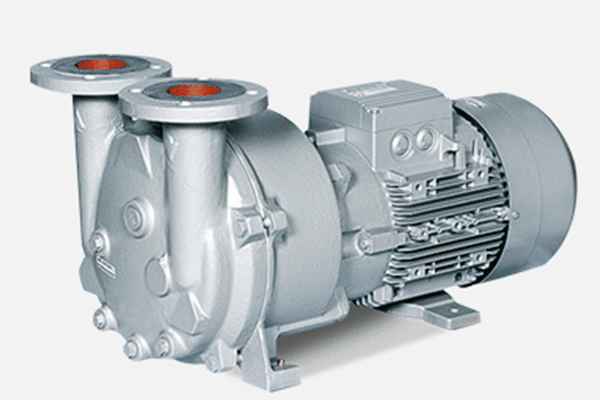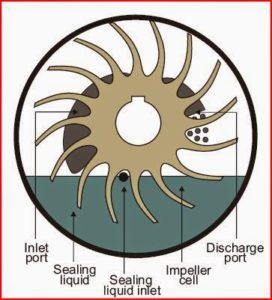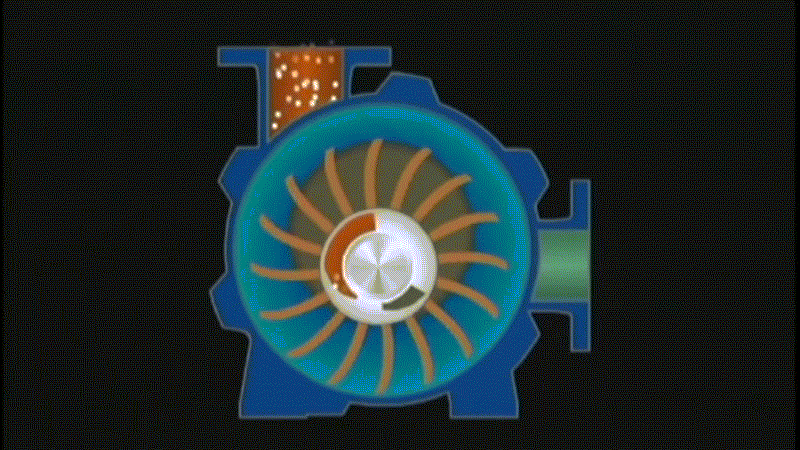Air Compressor Works
Post
Compressor Basics: Liquid Ring Pumps
November 03, 2017

Liquid Ring pumps are very simple systems, but it’s very complicated to explain how they work. There is a lot going on inside the pump, despite only having one moving part.
The pump uses centrifugal force on a sealing liquid, which acts like a piston in an ideal cylinder, to compress a gas trapped between the liquid and an impeller.
Say what?
Let’s step backwards a little bit….
A liquid, for all intents and purposes, is nearly incompressible. Of course you can put enough force on any liquid and it will compress, but it’s a large amount compared to a gas.
For instance, if we wanted to compress water, we would need about 29,000 to 30,000 psi to reduce its volume by 10% (depending on temperature). If we want do the same thing to air at sea level, that only takes between 1 and 2 psi. That’s a huge difference.
For the pressures that a liquid ring pump can achieve, we can say that the liquid in it does not compress, or it cannot be reduced in volume. The gas in the pump, however, can be compressed.
So let’s look at what’s going on in the pump.
This is the pump before it starts up:

There is the liquid in the bottom – could be oil, could be water, or possibly another liquid. This is called the sealing liquid.
At the bottom there’s a hole for the sealing liquid to enter the chamber.
In the middle of the pump, around the center of the impeller you can see the inlet and discharge ports. This is where the air will enter and leave.
Once the impeller starts spinning, the sealing liquid is thrown outward by centrifugal force.
Because the sealing liquid is denser than the air, it will occupy the outside, while the gas is trapped on the inside.
Here is an animation of the air flow. 
The blue is the sealing liquid, the orange space is air, and the white dots are air particles.
You can see that because the impeller is off-center, as the impeller rotates, the space that the air is trapped in gets smaller and smaller. The reduction in volume causes an increase in pressure.
Some of the sealing liquid gets moved downstream, as well. This has to be separated out and fed back into the pump.
So why do all this – why not just use another type of pump?
The advantage of liquid ring pumps is that they are very durable. They can take a beating and keep on going, like nothing happened.
There is only one moving part with no metal to metal contact, so there is very little wear. Also, the liquid in it helps keep the components cool, which also helps out the life span of the parts.
When used for vacuum duty, liquid ring pumps can suck in all types of junk and fluids and it doesn’t hurt them all (if they were designed and sized properly). Here in Florida, we have had cases where either a piston vacuum pump or a rotary vane vacuum pump was inadvertently sucking in sea water. This immediately ruins the vane or the piston pump. So we put in Rietschle 2BL liquid ring pumps, which use water as the sealing liquid. The internal parts are bronze or stainless steel. It often sucks in sea water, and there’s no problem.
Liquid ring pumps can be put in bad situations, extreme conditions, and suck in materials that would ruin other pumps. In addition to being durable, they also have great longevity. You can expect decades of service from a properly configured liquid ring pump, as long as you do the maintenance.
So what are the disadvantages of a liquid ring pump?
- Liquid ring pumps tend to be much less energy efficient than other technologies.
- Liquid ring pumps usually have a higher initial cost.
So there you have it. If you have a situation where other pumps keep failing, put in a liquid ring pump. Make sure you consult your compressor company on what type of sealing liquid to use in the pump and the materials that the pump is made out of – that can make or break you. For the sealing liquid, you’ll usually have the choice of oil-sealed or water-sealed. For the internal materials there will be a wide variety of choices. These choices will be determined by the material compatibility of what’s coming into the pump.
On the other hand, if you have a liquid ring pump or are looking at replacing an old one, and you have a situation where there is no extreme condition, and nothing but air is going into the pump, then another technology may be a better purchase. Liquid ring pumps are designed for rough conditions. If you don’t have a rough condition, you’re just wasting money and electricity on a pump you don’t need.
Contact Us
Contact Us
Palm beach:
1956 W 9th St
Riviera Beach, FL 33404
Monday – Friday 7:30 AM - 4:30 PM
Map and Directions
Miami:
7292 NW 25th St
Doral, FL 33122
Monday – Friday 7:30 AM - 4:30 PM
Map and Directions
Phone Number:
Areas We Serve
- Miami
- Fort Lauderdale
- Hollywood
- Boca Raton
- Stuart
- Vero Beach
- Delray Beach
- West Palm Beach
- Homestead
- Key West
- Fort Pierce






